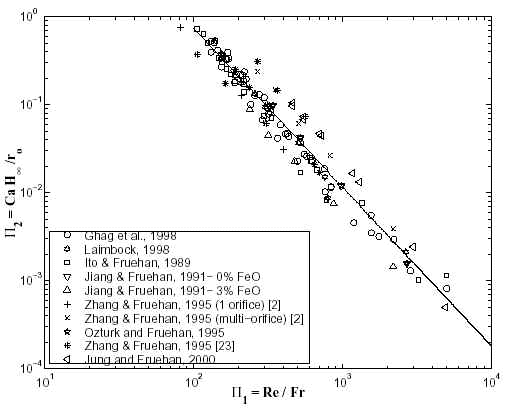The study presents an approach for predicting the thickness of isothermal foams produced by blowing gas in a liquid solution under steady-state conditions. The governing equation for the transient foam thickness has been non-dimensionalized, and two dimensionless numbers have been identified to describe the formation and stability of this type of foam: p1 = Re/Fr and p2 = Ca H/r0. Physical interpretation of the dimensionless numbers has been proposed, a power-law type relation has been assumed between P1 and P2 (i.e., P2 = K P1n ).
![]()
![]()
Experimental data available in the literature have been used to determine the empirical parameters of the correlation K and n. The experimental conditions cover a wide range of viscosity, density, surface tension, gas superficial velocity, and average bubble radius.

The model is valid for foams formed from high viscosity liquids bubbled with nitrogen, air, helium, hydrogen, and argon injected through single, multi-orifice nozzles or porous medium. Comparison between the correlation developed and the experimental data yields reasonable agreements (within 35% error), given the broadness of the bubble radius distribution around the mean value, the uncertainty of the experimental data and of the thermophysical properties. Predictions have been found to be very sensitive to the average bubble radius. A more refined model is still needed which should be supported by a careful experimental studies. Finally, suggestions are given to extend the present work to foams generated from low viscosity solutions.
Publications
D. Lotun and L. Pilon, 2005. Physical Modeling of Slag Foaming For Various Operating Conditions and Slag Compositions. ISIJ International, Vol. 45, No.6, pp. 835-840.
L. Pilon, A. G. Fedorov, and R. Viskanta, 2001. Steady-State Thickness of Liquid-Gas Foams. Journal of Colloid and Interface Science, Vol. 242, No. 2, pp. 425-436. doi:10.1006/jcis.2001.7802.